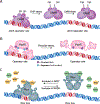Sense and sensor ability: redox-responsive regulators in Listeria monocytogenes
- PMID: 30412828
- PMCID: PMC6502700
- DOI: 10.1016/j.mib.2018.10.006
Sense and sensor ability: redox-responsive regulators in Listeria monocytogenes
Abstract
Listeria monocytogenes (Lm) is a Gram-positive bacterium that thrives in nature as a saprophyte and in the mammalian host as an intracellular pathogen. Both environments pose potential danger in the form of redox stress. In addition, endogenous reactive oxygen species (ROS) are continuously generated as by-products of aerobic metabolism. Redox stress from ROS can damage proteins, lipids, and DNA, making it highly advantageous for bacteria to evolve mechanisms to sense and detoxify ROS. This review focuses on the five redox-responsive regulators in Lm: OhrR (to sense organic hydroperoxides), PerR (peroxides), Rex (NAD+/NADH homeostasis), SpxA1/2 (disulfide stress), and PrfA (redox stress during infection).
Copyright © 2018 Elsevier Ltd. All rights reserved.
Conflict of interest statement
Conflict of Interest
The authors declare no conflict of interest.
Figures


References
Publication types
MeSH terms
Substances
Grants and funding
LinkOut - more resources
Full Text Sources

